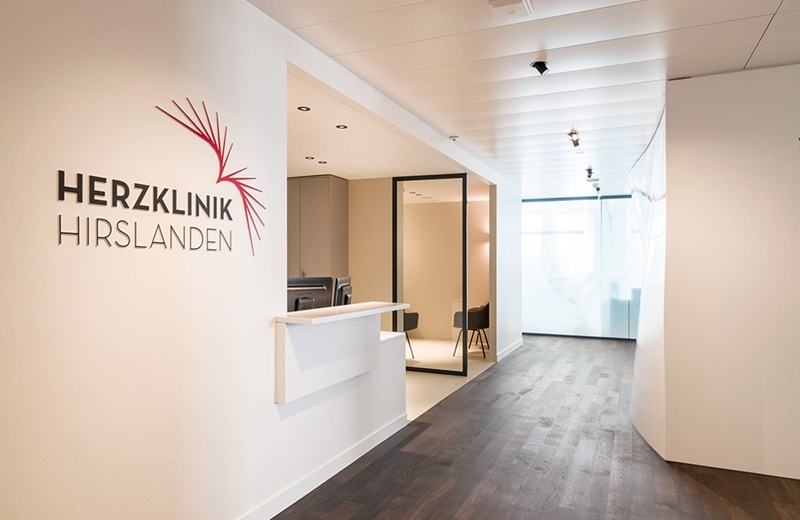Prof. Dr. Jürg Grünenfelder, specialist in cardiac and thoracic vascular surgery at the Hirslanden Heart Clinic, is a specialist in minimally invasive mitral valve reconstruction. Using this gentle surgical method, patients benefit from optimal results and are able to recover more quickly.
Interview with Prof. Dr. med. Jürg Grünenfelder
What is a mitral valve reconstruction?

Prof. Dr. med. Jürg Grünenfelder – Specialist in cardiac and thoracic vascular surgery – HerzKlinik Hirslanden
Prof. Dr. Jürg Grünenfelder: The mitral valve is one of the four heart valves and is located between the left atrium and the left ventricle. Whenever the heart contracts, it prevents the blood from flowing back into the atrium. The valve leaflets are attached directly to the heart muscle by chordae tendineae so that they close tightly with every contraction. If these threads are defective or the leaflets are perforated or overstretched, the valve can no longer completely fulfill its sealing function. During mitral valve reconstruction, these defects are repaired so that the heart can perform at its full capacity again.
How does heart valve disease develop?
Prof. Dr. Jürg Grünenfelder: Valve defects are sometimes congenital, but can also develop in the course of a lifetime due to genetic predisposition or connective tissue weakness. Unfortunately, it is not possible to take preventive measures, as there are no known risk factors. Mitral valve insufficiency is therefore not uncommon and is one of the most common valve diseases.
How is heart valve disease detected?
Prof. Dr. Jürg Grünenfelder: Mitral valve insufficiency often goes undetected. It is usually diagnosed when an unusual heart murmur is detected during the annual check-up with the family doctor. If the disease remains untreated over a long period of time, it can become noticeable through a reduction in performance, reduced heart function, atrial fibrillation or an enlarged heart. People over the age of 60 are usually affected.
In which patients is mitral valve surgery recommended?
Prof. Dr. Jürg Grünenfelder: Heart surgery always involves a certain amount of risk. It is therefore important to weigh up whether an operation is really necessary. Mild and moderate cases are not normally treated, as an operation only brings a relatively small improvement in quality of life. Surgery is only recommended for severe cases. However, it has also been shown that early treatment is particularly useful for mitral valve surgery. If the patient has already developed severe symptoms as described above, the results after surgery are less satisfactory than if surgery is performed immediately. In principle, any patient with mitral valve insufficiency is suitable for surgery. In general, however, it can be said that our younger, fit patients aged between 50 and 70 in particular benefit from an operation – they can expect a great improvement in quality of life as well as an extension of life.
How does mitral valve surgery work in detail?
Prof. Dr. Jürg Grünenfelder: Normally, a so-called sternotomy is performed for mitral valve surgery. This means that the sternum is opened to expose the heart. This results in a relatively large wound of around 15 to 20 centimetres in length. In minimally invasive surgery, a much smaller, lateral incision of around five to six centimetres is made above the ribs, which are then spread apart to make the heart accessible for the instruments. In both versions, the heart-lung machine is used – in the open procedure directly via the opening in the sternum, in the minimally invasive procedure via the inguinal vessels. There is also no difference in the duration of the operation.
What are the advantages of minimally invasive mitral valve surgery?
Prof. Dr. Jürg Grünenfelder: There are a few: The smaller wound is a much gentler procedure. It leads to less blood loss, a lower risk of secondary infections and kidney failure, so that the patient can leave the hospital earlier on average. In addition, this lateral approach provides a better direct view of the mitral valve, which makes the complex operation somewhat easier. This means that the valve can be reconstructed in most cases and does not have to be replaced with a prosthesis. This represents a foreign body and can become non-functional again after a certain period of time.
How established is the minimally invasive surgical technique in Switzerland?
Prof. Dr. Jürg Grünenfelder: The Hirslanden Heart Clinic is one of the few clinics in Switzerland where surgery for mitral valve insufficiency is routinely possible using a minimally invasive procedure. Internationally, this method is already becoming the standard instead of opening the chest, partly due to the numerous advantages for the patient described above: the same result is achieved with a smaller wound.


